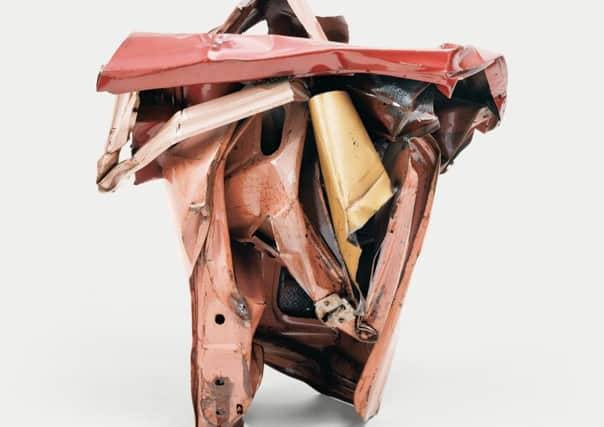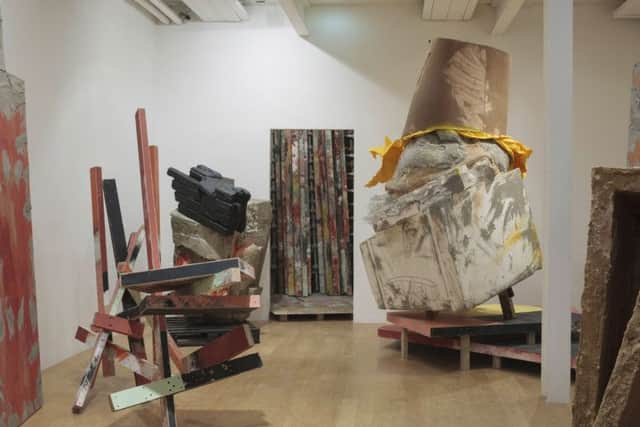Edinburgh displaying the art of destruction


The late US artist John Chamberlain, who died in 2011, was a heavyweight in many ways – a veteran of the fighting in the Pacific in the Second World War and a 6ft 4in boozing, brawling bear of a man, who was four times married. But before he studied at the Art Institute of Chicago on the GI Bill in 1951, and later made his way to Black Mountain College which was America’s own Bauhaus, he had trained as a hairdresser.
At Inverleith House, for the Edinburgh Art Festival, a grand yet concise survey show reveals that Chamberlain’s authority was something to do with that weird jump in precision and scale between the swish of the scissors and the welder’s arc. For if Chamberlain became famous for his sculpture crafted from mangled motor cars, he had a uniquely delicate balance and a receptivity to the poetry of found rather than crafted materials.
Advertisement
Hide AdThe popular legend had it that shearing locks was a great way to meet girls. But Chamberlain occupies a more nuanced and oddly pivotal position in the history of art in America between untrammelled masculinity and the cool, queer modernity of the Warhol crowd. He is the link between the Cedar Tavern, the New York HQ of the abstract expressionists, and Max’s Kansas City, the bar where art and fashion met, where his sculpture hung in the front room and where minimalism, pop art and conceptualism held sway in the conversation.


Chamberlain’s automobile sculptures seem to stand of their own accord. Whether slouching against the wall or standing free, they are a delicate conundrum of mashed fender, bashed panel and lots of free space; a tangle of chance and deliberation. But they are surprisingly light in tone. It was the minimalist par excellence Donald Judd, an early champion, who best understood their alliance with pop culture in their materials and their ready-made colours: “The hard, sweet, pastel enamels, frequently roses and ceruleans, of Detroit’s imitation elegance for the poor.”
This might have been a rather shallow show, in a way which would not have been unique at Inverleith House: an exhibition featuring a male giant of US art, a powerful blue-chip gallery (in this case Gagosian) and some decorative but less than substantial late career works – in this case the delightful yet slight outdoor aluminium sculptures, like giant twists of pastel tinfoil, that are lurking in the shrubbery of the Royal Botanic Garden.
These works, though, are overshadowed by four rooms of superb loans from the Dia Art Foundation, which show how Chamberlain worked in the 1970s when he became tired of crushed metal and its associations. In the series entitled Socket, he swilled paint in crushed coffee cans. In the Penthouse works, paper bags were blown up, exploded and remade like brown paper blooms with paint and resin. In the Stuffed Dog works, carving, binding and splattering urethane foam became a surprisingly effective way of reimagining the sculptor’s task.
In the bars he frequented, Chamberlain was known for the way he carefully, artfully crushed his cigarette packets when they were empty. His work has that insouciance and that confusing application of skill and circumstance to the incongruous material he encountered.
At the Fruitmarket Gallery another blue-chip sculptor, British artist Phyllida Barlow, has used everyday construction materials to occupy the building with stubborn force. An influential sculptor and professor at the Slade School of Fine Art, Barlow, who was born in 1944 and studied at Chelsea in the 1960s, has had a long, prestigious career, but she has also enjoyed a recent ascent to global prominence.
Advertisement
Hide AdThis is in some part due to the muscle of commercial gallery Hauser and Wirth, where her 2011 show RIG reminded the international art world of what she made, and was made of, and in large part to her bravura 2014 installation for the Duveen Galleries at Tate Britain, a teetering, unruly work which brought the slow, dirty River Thames and its industrial detritus back into the pristine public space.
It’s a delightful but tricky position for the artist: a moment when work that was long ago made alone at night, when teaching and children allowed, is now created on a vast scale in major galleries worldwide. The requirements of rigorous forward planning, assistants and shed loads of materials risks the loss of hands-on wrestling with the work. Barlow has responded to recent circumstances with a renewed emphasis on making and improvisation. Bringing a number of elements pre-made to the gallery she has then joined and aggregated them in an installation that makes it feel like the roof has fallen in.
Advertisement
Hide AdShe is nothing if not forceful. It’s a happy circumstance that, in an awkwardly shaped and often clinical gallery space where order usually reigns, Barlow’s work has brought a disciplined but brooding physicality, a stubborn sculptural insistence. The names of individual elements of the work say it all: barrier, blockade, lookout post. The Fruitmarket is under siege and Barlow’s sculpture is in equilibrium: both the siege engine that will be the space’s undoing and the defended citadel which will stoically resist. In a sequence of dead-ended labyrinths, blind allies and obstructions, it is a construction site, where the final construction will never be allowed resolution.
Barlow brings all manner of techniques: stacking, leaning, binding and smearing, scraping and daubing, rolling and wrapping. She conceals rather than reveals; the work squats and looms. Her characteristic material here is scrim and cement, and if the work is coated in it, the walls are also spattered. That she refused to let them clean the walls says it all.
John Chamberlain until 4 October; Phyllida Barlow until 18 October